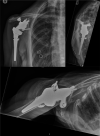Case Report: Kingella kingae causing prosthetic joint infection in an adult
- PMID: 37691837
- PMCID: PMC10484313
- DOI: 10.1099/acmi.0.000559.v3
Case Report: Kingella kingae causing prosthetic joint infection in an adult
Abstract
Introduction: Kingella kingae is a Gram-negative micro-organism that is rarely isolated as a pathogen in the adult population. Although widely reported to affect prosthetic heart valves, there have been no previously reported cases of K. kingae infecting prosthetic joints in adults.
Case presentation: A 61-year-old patient with a history of rheumatoid arthritis presented with insidious onset of pain and swelling in her right shoulder, which had progressed to a discharging sinus. The patient had undergone a total shoulder replacement 11 years previously and had not developed any prior post-operative infections. She had been taking anti-TNF medication for 5 years prior to review for her rheumatoid disease. The patient underwent a two-stage revision replacement procedure, including implant removal, sinus excision and debridement. Deep tissue samples grew K. kingae post-operatively. The patient was commenced on intravenous ceftriaxone for 14 days, followed by a further 28 days of oral ciprofloxacin. A second-stage custom shoulder replacement was undertaken 10 months following the first stage and the patient made a good functional recovery.
Conclusion: The authors suggest that clinicians should be attuned to K. kingae as a potential pathogen for prosthetic joint infection, particularly in patients who are immunosuppressed. Two-stage revision procedures can ensure a favourable outcome and eradication of this pathogen from the joint. Beta lactams remain the principal antibiotic of choice.
Keywords: Kingella kingae; immunocompromised; prosthetic joint infection.
© 2023 The Authors.
Conflict of interest statement
The authors declare that there are no conflicts of interest.
Figures
References
-
- Yagupsky P, Dagan R, Howard CB, Einhorn M, Kassis I, et al. Clinical features and epidemiology of invasive Kingella kingae infections in southern Israel. Pediatrics. 1993;92:800–804. - PubMed
-
- Goutzmanis JJ, Gonis G, Gilbert GL. Kingella kingae infection in children: ten cases and a review of the literature. Pediatr Infect Dis J. 1991;10:677–683. - PubMed
Publication types
LinkOut - more resources
Full Text Sources


